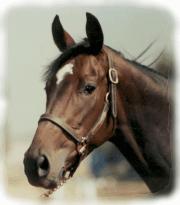
A Horse, of Course with Don Blazer |

If you enjoy learning about horses, then you'll love
our Community College online Personal Enrichment courses. Each month you'll find a new column on our web site. We hope you'll enjoy it, and maybe e-mail us with questions or suggestions for other columns. A Horse, Of Course is a monthly column syndicated by Success Is Easy. If you like the column, call your local newspaper, or local horse publication and ask them to subscribe by contacting Success Is Easy. |
A horse can be brindled, but it can't
be brindle! At least not yet. Brindle means having a coat streaked or spotted with a darker color. There are no registered brindles in the horse world. That doesn't mean they aren't there, but rare; it means they aren't registered. And that seems funny, since there are registries for just about everything and every color. The last time I looked there were 173 different "breed" registries, including the Bay Horse Registry. Brindle is kind of like having a bay horse that has had chocolate syrup poured over his withers, back and hips. The syrup runs down the horse's shoulders, sides and hind legs and makes irregular stripes. You know what the color "brindle" looks like in dogs; well, it's the same in horses. Usually brindle horses have texturing in their coat, similar to that seen in Appaloosa horses. If you ask a horseman, he'll tell you there is no such thing as a brindle horse. Brindle is simply not known as a color for a horse. If you ask the breed associations, they'll tell you they don't recognize the color brindle. It isn't that they are color blind, or that the color doesn't exist. It just means they don't know what to do with it. Sharon Batteate of Stockton, CA knows what to do about the color; in fact, she is probably the world's authority on brindle horses. She has been leading a worldwide effort to learn more about brindles since late in 1989. An example of what Sharon is up against when trying to get brindle recognized as a color: an AQHA brindle mare is registered as a roan, while her brindle gelding is registered as a "brindle dun" by the International Buckskin Horse Association. The roan, according to Sharon, is a brindle and the dun is a brindle without the dun factor. By color, both are incorrectly identified. But you can't argue with breed associations; they have their own rules about things. I know Sharon is correct about the brindle horse because I owned one. He was a Thoroughbred, registered as a dark brown or bay. Now doesn't that description impart a great deal about the accuracy of color registrations. Sort of like having a "breeding stock" Paint…if he ain't a paint, he ain't…but don't try to argue that with the association. The first record of the brindle pattern in horses seems to have been made by J.A. Lusis in the publication Genetica vol. 23, 1942. According to Sharon, Lusis details the coloring of a Russian cab horse from the 1880s and documents it with photographs. Brindle occurs in such diverse breeds as Arabians, Thoroughbreds, mustangs, Quarter Horses, Bavarian Warmbloods, Russia and Spanish breeds and horses of the Netherlands. "We are not sure yet if the brindle pattern is from a single gene, or several, as in pinto/Paint spotting which is the result of multiple genes," says Sharon. Sharon says her research indicates the brindle pattern seems to be inheritable, especially in terms of coat texturing. But the extent of striping is highly variable. Of the known brindle stallions, Sharon reports, none have produced brindle color in foals. "I believe we are on the right track, but it may be years before we have enough data to really know," Sharon says. For more information on brindle horses, visit Sharon's web site: http://members.aol.com/battyatty/ I wonder if a Zebra is just a white brindle? |